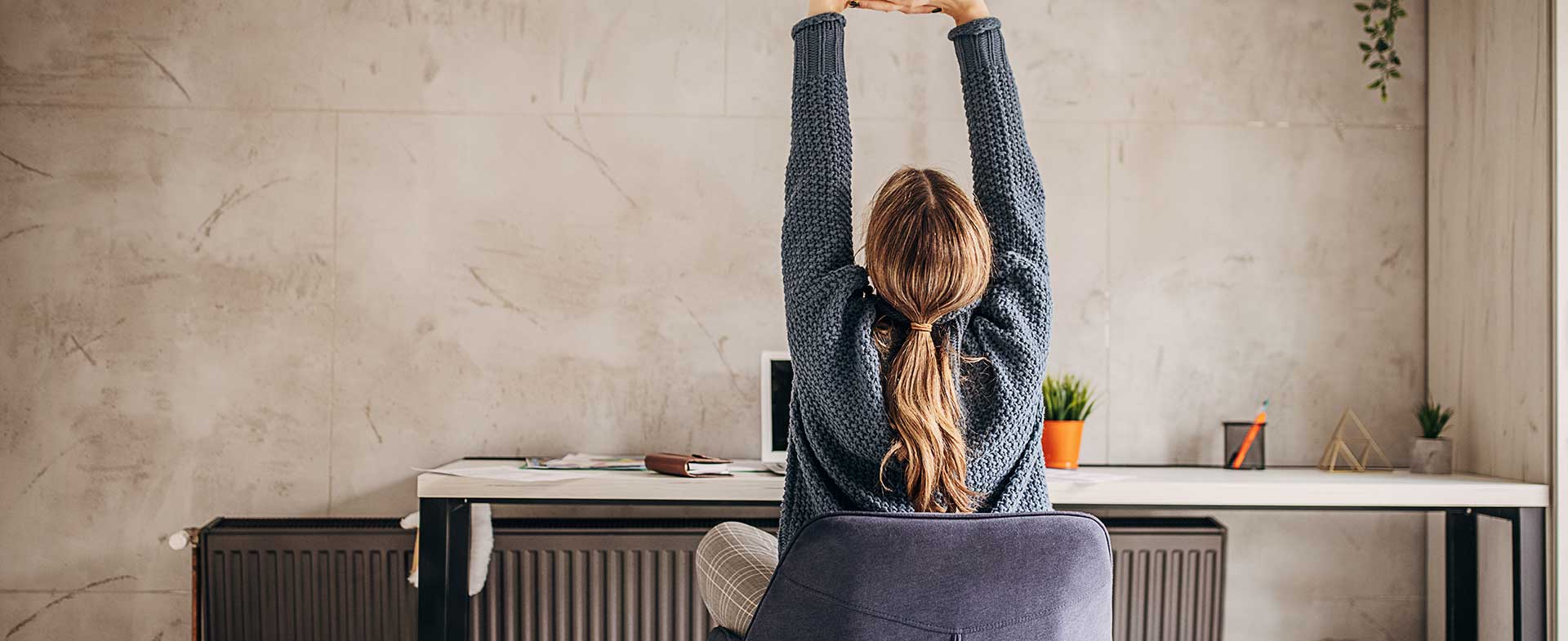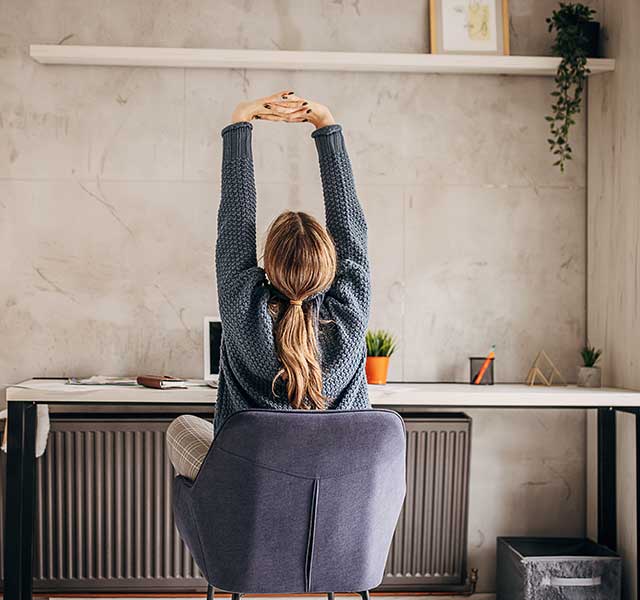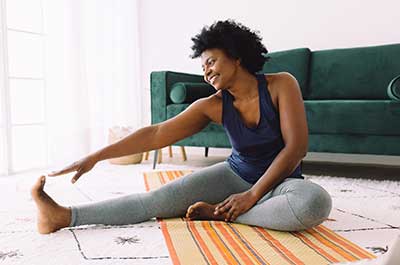You already know that exercise is important, including cardio exercises that get your heart pumping and strength training to keep muscles fit. But there’s one more category you shouldn’t ignore: stretching.
Ronald Benbow, M.S., a clinical exercise physiologist and clinical research coordinator at Henry Ford Health, explains why stretching is so important—and which six simple stretching exercises to include in your regular routine.
Benefits of Stretching
Your musculoskeletal system is designed to work together to support, protect and move your body. “Think of it as a form of dance, like the tango,” Benbow says. “There’s a dynamic push and pull, a harmonious give and take within our bodies that enables us to move with fluidity and rhythm in our daily lives.” But it’s common to overuse some muscles while underusing others, whether you’re on your feet or sitting at a desk all day. That creates an opportunity for muscle imbalances that can lead to muscle pain, tightness and limited range of motion. Those imbalances can also increase your risk for injury, Benbow says.
That’s where stretching comes in. “Stretching can act as a preventive method for addressing overactive muscles, improving range of motion, and reducing pain and stiffness,” he says.
Aim to start out stretching two days a week, and gradually build up to three or more days. “See your doctor if you experience any unusual pain or shortness of breath with activity,” Benbow cautions. “If you have concerns about stretching activities, your physician can advise you about which stretching exercises are safe or refer you to a physical therapist.”
6 Everyday Stretching Exercises
Benbow recommends these simple exercises that can be done almost anywhere, with no equipment. He advises stretching as deeply as your flexibility allows, until you feel mild discomfort — but you shouldn’t feel pain.
1. Seated hamstring stretch
The hamstrings are a group of muscles that run along the back of the thigh. They’re vital for movements like walking and running. “Hamstring stretches may benefit people who sit for long periods,” Benbow says. Here’s how to do it.
- Sit in a chair with your right leg extended straight and flexed at the ankle, with your right heel planted into the ground.
- Take a breath in. As you exhale slowly and deeply, hinge forward at the hips, keeping your back straight.
- Lean into the stretch until you feel a gentle pull along the back of the hamstring and into the calf.
- With each exhale, gradually intensify the stretch as much as your flexibility allows.
- Hold for 10 to 30 seconds, or 30-60 seconds for older adults.
- Repeat with your left leg.

Meet With An Exercise Physiologist
2. Quadriceps stretch
The quadriceps (or quad) muscles run along the front of the thigh. They’re important for daily activities like climbing stairs or getting up from a chair. Benbow suggests this simple stretch for your quads.
- Stand upright facing a wall, with your knees hip distance apart.
- Bend your right leg at the knee, bringing your foot up toward your backside.
- For a deeper stretch, grab your foot at the ankle, gently pulling the foot in closer to your hip. Place a hand on the wall to steady yourself if necessary.
- Hold for 10-30 seconds, or 30-60 seconds for older adults.
- Repeat the stretch with your left leg.
3. Calf stretch
Your calf muscles run along the back of your lower leg. They’re important for walking, running and jumping, and help to protect your foot and ankle joints. Benbow suggests this simple stretch to target the calf:
- Stand with your legs hip-distance apart. Step your left leg forward and bend your left knee.
- Keeping your right leg straight, lean forward with your upper body, feeling a stretch along the back of your right calf. (It’s okay if your heel doesn’t touch the ground.)
- Hold for 10-30 seconds, or 30-60 seconds for older adults.
- Repeat the stretch on your opposite leg.
4. Chest and shoulder stretch (skydive stretch)
Your chest and shoulders can become tight and hunched, especially if you’re sitting or typing all day. This stretch will give your chest and shoulders a nice release.
- Stand with your arms bent 90 degrees at the elbows, palms facing forward and at the side of both ears, with elbows raised to shoulder height. (Imagine you’re in a skydiving pose, but in a standing position.)
- Squeeze your shoulders back, opening the chest muscles as you squeeze your shoulder blades together. “Imagine that you’re holding a pencil between your shoulder blades, and you don’t want to drop it,” Benbow says.
- Hold for 10-30 seconds, or 30-60 seconds for older adults.
- Relax and repeat several times.
- As you squeeze, imagine pulling your shoulders down toward your back pockets. Take care not to raise your shoulders toward your ears.
5. Mid to upper back stretch
Your middle and upper back muscles have big jobs to do, keeping you stable, maintaining your posture and helping your whole body move. This stretch helps soothe stiff muscles in your mid and upper back, which can help reduce the risk of back pain.
- Sit or stand with your back straight. “Imagine there’s a string attached to the crown of your head, pulling your spine gently into its natural curve,” Benbow says.
- Extend your arms in front of your chest at shoulder level, palms facing forward, fingers interlaced together.
- Press the palms of your hands forward, keeping your elbows soft. Imagine dropping your shoulders down to your back pockets. Imagine you’re pressing your palms against an invisible wall in front of you.
- Tuck your chin down to your chest to extend the stretch into the back of your neck and mid back.
- Hold for 10-30 seconds, or 30-60 seconds for older adults.
6. Spinal twist
“We don’t just bend, lift, push and pull. We rotate as well,” Benbow says. This stretch targets your back and core muscles to help you move with ease in every direction.
- Sit with your back straight. Place your feet on the floor and your knees together.
- Take a deep breath in. As you exhale slowly and deeply, rotate your upper body to the right. Hold for 10 to 30 seconds, or 30-60 seconds for older adults.
Inhale as you turn back to face forward. Exhaling again, rotate your upper body to the left and hold.
Tips for Safe Stretches
New to stretching? Benbow offers some pointers to keep in mind.
- Get warm: Stretching after a workout or at the end of the day is great, since your body is likely warmed up. Midday stretches are another great option for breaking up the workday. If you like to stretch first thing, warm up your muscles first with a brisk 5- or 10-minute walk.
- It shouldn’t hurt: You should feel a pull when you’re stretching, but it shouldn’t cause pain. The rule of thumb is to stretch only until you feel mild tension but no pain. If you have existing pain or experience any unusual new pain, stop the stretch and consult with your doctor or a physical therapist.
- Start low and progress slow: Start with one set of each stretching exercise. As you get used to the stretches, you can hold them for longer, do more repetitions and incorporate other types of flexibility exercises.
- Older means longer: For adults over 65, expert guidelines recommend holding stretches longer, since it can take longer for the body to settle into a stretch. Work up to holding stretches for 30-60 seconds, Benbow says.
- Break it up: No time to fit in a whole stretching routine? No problem! Break it up into several “snack-sized” stretch breaks spread throughout the day. “You have the creative freedom to decide how and when to integrate stretching into your schedule,” he says. “The important thing is just to start where you are and progress from there.”
Reviewed by Ronald Benbow, M.S., a clinical exercise physiologist and clinical research coordinator at Henry Ford Health.



